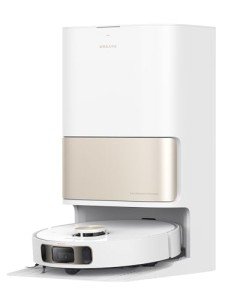The Evolution of Robot Hoovers: Revolutionizing Home Cleaning
Robot hoovers, likewise known as robotic vacuum, have changed how people approach home cleaning tasks. Initially introduced in the late 1990s, these self-governing devices have progressed quickly due to developments in innovation, synthetic intelligence, and device learning. Today, they are geared up with an array of functions that make them highly efficient in preserving tidiness in living areas. This post explores the history, functioning, benefits, and future of robot hoovers.
The History of Robot Hoovers
The principle of robotic vacuums dates back to the 1970s, but it wasn't up until the launch of the Roomba by iRobot in 2002 that they gained mainstream attention. The Roomba was developed to automatically browse different surface areas, avoiding challenges while efficiently cleaning floorings. Since then, a number of substantial developments have happened, consisting of:
| Year | Advancement |
|---|---|
| 1996 | First model robotic vacuum cleaner established by a Japanese business. |
| 2002 | iRobot releases the Roomba, mass popularizing robotic vacuums. |
| 2004 | Intro of the very first Roomba with a dirt detection sensing unit. |
| 2011 | Launch of designs with cordless abilities and smart device integration. |
| 2020 | Advanced models including AI, boosted navigation systems, and mopping abilities. |
How Robot Hoovers Work
Robot hoovers operate on a mix of sensors, video cameras, and algorithms that allow them to tidy efficiently. Key elements of these gadgets consist of:
Sensors:
- Obstacle Avoidance Sensors: Detect walls, furnishings, and even stairs, preventing collisions and falls.
- Dirt Detection Sensors: Identify locations that need more comprehensive cleaning.
Navigation:
- Gyroscopes: Help figure out the robot's orientation and motion.
- Video cameras and Lidar: Enable mapping of the home environment to create optimal cleaning paths.
Cleaning Mechanisms:
- Vacuum Motors: Generate suction to get dirt and particles.
- Brush Rollers: Agitate dirt out of carpets for deeper cleaning.
Power Supply:
- Batteries: Rechargeable lithium-ion batteries supply the required power for extended cleaning cycles.
Interface:
- Mobile Apps and Smart Home Integration: Users can arrange cleansings, screen efficiency, and manage the robot from another location.
Benefits of Robot Hoovers
Robot hoovers use various advantages, making them an appealing choice for modern homes:
- Time-Saving: Automated cleaning permits users to focus on other jobs while the robot efficiently cleans floors.
- Convenience: Many models can be set up for cleaning sessions, ensuring that homes remain tidy without manual effort.
- Availability: Ideal for individuals with mobility challenges or busy lifestyles, making it possible for easier home maintenance.
- Constant Cleaning: Regular, automated cleansings decrease the build-up of dirt and irritants, contributing to a much healthier living environment.
- Smart Technology: Integration with smart home systems permits increased control and modification.
Limitations of Robot Hoovers
In spite of their benefits, robot hoovers come with certain constraints:
- Navigation Challenges: They may have a hard time in chaotic spaces or with specific floor types such as high-pile carpets.
- Battery Life: Most models require routine charging, which can restrict cleaning duration.
- Maintenance: Regular cleaning of filters, brushes, and clearing dust bins is required for optimum efficiency.
- Price: Advanced models can be costly compared to traditional vacuum cleaners.
The Future of Robot Hoovers
As technology continues to progress, the future of robot hoovers looks promising. Anticipated developments consist of:
- Improved AI: Enhanced algorithms will enable for better item acknowledgment and vibrant mapping of spaces.
- Hybrid Models: Integration of vacuuming and mopping abilities in one device will provide a thorough cleaning solution.
- Increased Autonomy: Future designs may navigate even the most complex environments without human intervention.
- Sustainability: Battery technology developments will lead to longer-lasting, more energy-efficient robots.
Frequently Asked Questions (FAQs)
1. Are robot hoovers reliable for pet hair elimination?
Yes, numerous robot hoovers are particularly designed to tackle family pet hair with effective suction and specialized brushes that decrease tangling.
2. How do robot hoovers navigate around furnishings?
Robot hoovers use a mix of sensing units and cams to detect obstacles, allowing them to navigate around furnishings and prevent accidents.
3. Can robot hoovers clean carpets?
The majority of modern-day robot hoovers are effective on both hard floorings and carpets. It is suggested to inspect the specs of private designs for particular efficiency.
4. Do robot hoovers need programming?
Many robot hoovers feature easy to use apps that enable owners to set schedules and personalize cleaning choices, making shows straightforward.
5. How robotic vacuum cleaner deals do robot hoovers cost?
Rates for robot hoovers differ commonly, ranging from ₤ 200 to around ₤ 1,500, depending upon functions and brand name.
Robot hoovers have come a long method because their inception, providing an efficient and convenient cleaning option for modern households. Their increasing ability and intelligence make them a practical choice for people aiming to streamline their cleaning regimens. As innovation continues to advance, robot hoovers will likely end up being even more capable, offering extra functions that accommodate the progressing needs of users. Their journey from novelty to requirement highlights an essential shift in how society approaches home maintenance, marking a substantial milestone in the crossway of technology and life.

